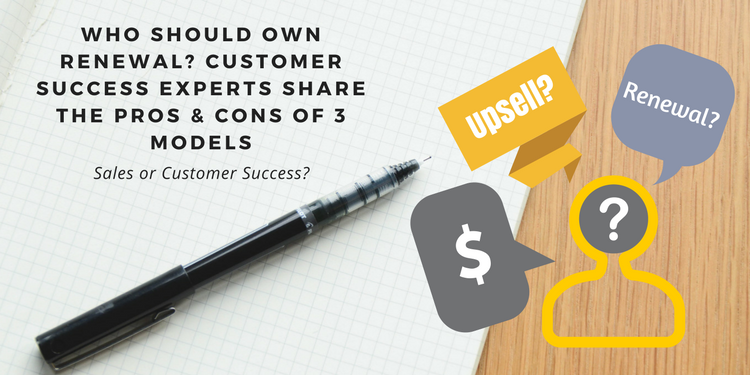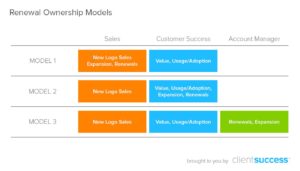Who Should Own Renewal? Customer Success Experts Share the Pros & Cons of 3 Different Models

A year has gone by, and it’s time for SaaS subscription renewal. Who reaches out to close the renewal, the Account Executive, CSM or Account Manager?
In two words, it depends. In five words, it depends and will change.
In order to ensure your company’s growth and reputation, you need a harmonious ecosystem of teams with proper compensation and incentives to fit the size and nature of your company. Upsells and renewals come as a natural result of successful adoption. Making sure your CSMs can perform optimally results in an easier job for whoever you chose to own the “commercial” aspects of the customer relationship.
During August’s Customer Success Meetup in San Francisco, Dave Blake, founder and CEO of ClientSuccess, Angeline Felix, Customer Success Manager at New Relic, and Sylvia Kuyel, Customer Success Strategic & International Lead at Cloudflare, discussed the different facets of three ownership models at their own organizations and from previous experience. Most SaaS companies will fall under one of three models: the account executive owning the renewal, the CSM owning the renewal, or an account manager owning the renewal, and all three have their perks and problems.
Model 1: The Account Executive/ Sales owns the expansion and renewal
The first model they discussed was the model where the account executive owns the renewal and all the “commercial” parts of the client relationship. Dave Blake, who has seen all three models, says that organizations where the renewal process is complex, or where you’re dealing with large accounts with labor and resource intense negotiations would do best under this model. The key to making this model work is fostering a strong, collaborative relationship between the AE and the CSM. He has seen teams fall into the trap of the AE treating the CSM like a secretary or administrator, which creates resentment and does not add any value for the organization’s customers.
A problem that can happen within this model is that AEs, in their sales mindsets, can start neglecting their current client base in order to pursue the next potential customer. At New Relic, Angeline Felix has a system where if a customer downgrades, a “spot-back” is on their record, meaning AEs “get dinged…it’s in their best interest to stay engaged, continuing the relationship through the entire customer life cycle, and through the adoption phase.”
In Sylvia Kuyel’s experience at Cloudflare, “in our early stages we were one bundled product, which means there’s not a lot of upsell. AEs will naturally be interested in large accounts because they see one business unit and then they want the ins to the additional ones.”
You can also run into the opposite problem, where AEs have an easier job expanding in their existing customer base, focus too much on them, and stop going after new logos, which is what happened at ClientSuccess. They fixed this by changing the comp plan for the AEs to push them to hunt new logos.
Model 2: The Customer Success Manager owns expansion and renewal
Discussion then led to the second model, where the CSM owns all of the relationship, including expansion and renewal. Dave Blake has been seeing this model across the industry more and more and this is the model that Cloudflare follows. Coming from a venture capitalist background, Sylvia knows that when valuing a company, people look at how risky their recurring revenue is and the heavy influence customer success has on this. She emphasized that the main reason this works for Cloudflare is that all their customers are on auto-renew contracts with a 60-day notice period.
“ The key to success here is fairly straightforward renewals that aren’t high maintenance, and the experience and maturity of your CS team. Some teams don’t have the negotiating experience or want that pressure.” Dave Blake, founder and CEO of ClientSuccess
Even though this is the majority of their customers, she says that when dealing with large accounts with long complex initial negotiations, it makes sense to bring in the AE because they have all the contacts, and they negotiate every day. They have a long standing relationship with the AE, even though renewal is truly a customer success number.
“As long as you’ve done a good job of driving the adoption along the way, the renewal itself is not a negotiation process.” Sylvia Kuyel, Customer Success Strategic & International Lead at Cloudflare
All three CSMs in the latest panel for the Customer Success Meetup felt strong ownership over expansion and renewal. According to Erica Pearson from Periscope Data, “ I own it all; it is my relationship with the client. I am their partner.” Their job is to get their clients value, with renewal being part of the CSM’s reward for doing the job right. Cloudflare recognizes the heavy workload that is involved when CSMs own everything. They set a global CS team goal that contributes to their comp but it is not individual. They do not want CSMs getting possessive over their accounts, and this encourages them to help each other out when one CSM has a particularly heavy day or week.
Many are hesitant to have CSMs own expansion and renewal because they fear that CSMs will lose the “trusted adviser” role, but Dave, Angeline and Sylvia all disagree with this based on experience. Customers tend to prefer having the trusted adviser to talk to about the commercial aspects, rather than bringing in a sales rep. They want someone who knows their business and if the commercial interactions are done right, CSMs can actually gain more trust as an adviser.
Model 3: A separate sales team of Account Managers own expansion and renewal
This last model brings in a third party into the organization’s ecosystem, a dedicated team of Account Managers who specialize in expansion and renewal. There is an undeniable benefit of specialization that comes with this model, letting AEs focus on new logos and CSMs focus on adoption. However, none of the experts at August’s Meetup were keen on this model, even having seen other companies successfully use it. Dave and Angeline found that customers are overwhelmed, having so many introductions and relationships to maintain. Sylvia suggested that if there is noticeable tension between the trusted adviser role and the commercial duties, then this is the model for you. It’s important to clearly delineate the duties among these three roles, with appropriate comp and incentives to drive the individuals in these roles.
Lana Pucket, a CSM at WalkMe gave insight into her experience with this model and relationship during the most recent Customer Success Meetup, saying that she executes the entire lead up to the renewal, but the AM comes in to handle the renewal contract. She noted that 20% of her salary is based on renewals, tying her salary to a number that she does not own according to the roles within her organization.
Having previously managed an AM team, Angeline says this model worked at that unnamed company, but you have to think about the type of person you are hiring for each role. The AM needs a balance between the CSM mindset of customer care and the AE mindset of making the sale. To learn more about the traits you should look for in a CSM, check out this article.
Tailoring it for you
Depending on the product you’re selling, the maturity of your organization, and the size of your customers, you may need to switch from one ownership model to another. Through this transition, remember to define the roles clearly to your customers, aligning to their needs. All of this will result in high expansion and successful renewals.
Retain more customers. Sign up today for free Net Promoter Score feedback with InMoment.


